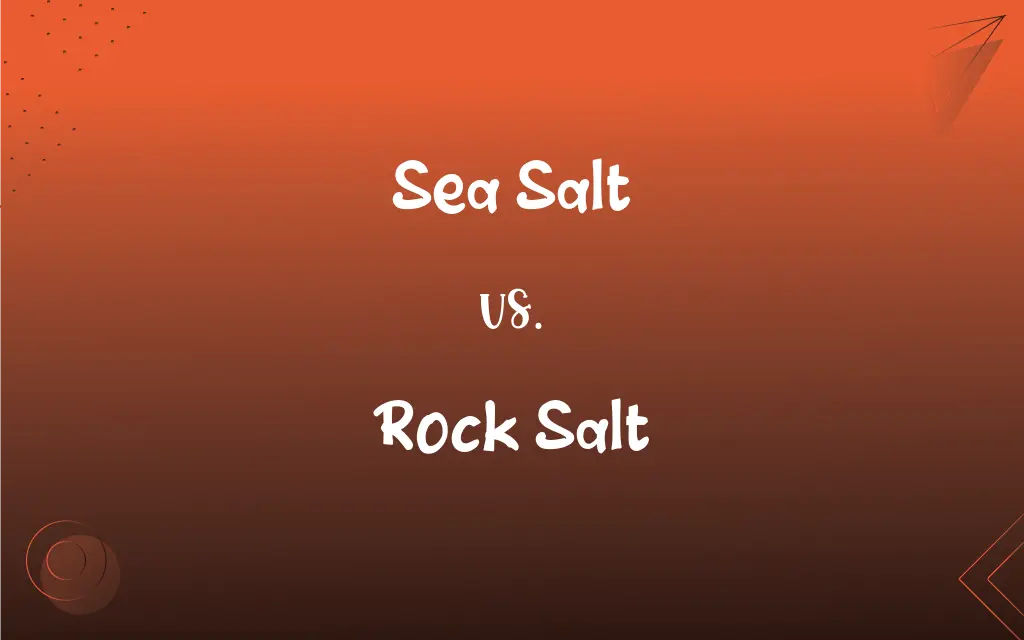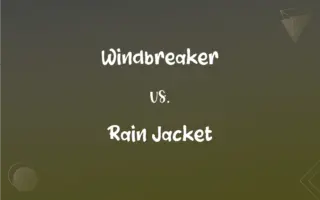Sea Salt vs. Rock Salt: What's the Difference?
Edited by Janet White || By Harlon Moss || Updated on October 21, 2023
Sea salt is obtained through evaporating seawater; rock salt is mined from underground salt deposits.

Key Differences
Sea salt is harvested by evaporating seawater, capturing the salt that remains. Conversely, rock salt is extracted from large underground deposits which were formed from ancient seas and lakes.
Due to their differing sources, sea salt typically contains a variety of minerals from the ocean, giving it a complex flavor. Rock salt, being from ancient deposits, often has fewer minerals, resulting in a more straightforward salty taste.
The texture differs between the two as well; sea salt can be found in both fine and coarse varieties, while rock salt usually has large, chunky crystals, making it popular for uses like ice cream making and de-icing roads.
While sea salt is often praised for its slightly briny flavor and is commonly used in gourmet cooking and as a finishing salt, rock salt is generally less expensive and is used in industrial applications, cooking, and household chores.
The coloration of sea salt can vary based on its mineral content and source, ranging from white to pink to gray. In contrast, rock salt is typically white, though impurities can sometimes give it different hues.
ADVERTISEMENT
Comparison Chart
Source
Evaporated seawater
Mined from underground deposits
Mineral Content
Varies; often higher
Typically lower
Texture
Fine to coarse
Chunky crystals
Common Uses
Cooking, finishing dishes
De-icing, cooking
Color
Varies (white, pink, gray)
Mostly white
ADVERTISEMENT
Sea Salt and Rock Salt Definitions
Sea Salt
A culinary ingredient sourced directly from the sea.
The caramel had a hint of sea salt, giving it a delightful contrast.
Rock Salt
Crystalline salt often used in industrial applications.
The machine churned the cream using rock salt and ice.
Sea Salt
Salt produced by evaporating seawater.
She sprinkled sea salt on her fresh salad for added flavor.
Rock Salt
Natural salt extracted from ancient seabed formations.
The cavern was full of rock salt deposits.
Sea Salt
Salt that contains trace minerals from the ocean.
Many chefs prefer sea salt for its rich and complex taste.
Rock Salt
Salt mined from ancient underground deposits.
They used rock salt to melt the ice on the driveway.
Sea Salt
Unrefined salt harvested from sea evaporation.
For a gourmet touch, she added sea salt to the grilled fish.
Rock Salt
Unprocessed salt derived from sedimentary mineral deposits.
We stored the rock salt in large bags for winter.
Sea Salt
Naturally derived salt with varied mineral content.
I replaced table salt with sea salt for a healthier option.
Rock Salt
Coarse salt sourced from beneath the Earth's surface.
Making homemade ice cream is easier with rock salt.
FAQs
Does sea salt have more minerals?
Yes, sea salt often contains a variety of minerals from the ocean.
How is rock salt different from sea salt?
Rock salt is mined from underground deposits, while sea salt is harvested from evaporated seawater.
Is sea salt healthier than rock salt?
Both are primarily sodium chloride; however, sea salt may have additional minerals. Health differences are minor.
Is rock salt always white?
Mostly, but impurities can give it different hues.
Are there any environmental concerns with sea salt production?
Overharvesting can affect local ecosystems, but sustainable practices can mitigate impacts.
Which salt is more expensive?
Generally, sea salt, especially gourmet varieties, can be more expensive than rock salt.
What is sea salt?
Sea salt is salt produced by evaporating seawater.
What is the typical use for rock salt?
Rock salt is used for de-icing roads, cooking, and certain industrial applications.
Can I use sea salt and rock salt interchangeably in recipes?
Generally, yes, but sea salt might impart a different flavor due to its mineral content.
Why does sea salt have different colors?
The color varies based on its mineral content and source.
Can I use rock salt in a salt grinder?
Yes, if it's food-grade rock salt, it can be ground for culinary uses.
How are the minerals in sea salt beneficial?
They can add flavor and small amounts of essential minerals, though the amounts are typically minor.
Why is rock salt used to make ice cream?
Rock salt lowers the freezing point of ice, helping churn and freeze the mixture.
Can I find both salts in regular grocery stores?
Yes, most stores carry both sea salt and rock salt.
Why is rock salt chunkier?
Rock salt is mined in large crystals from underground deposits.
Can I use rock salt on food?
Yes, but ensure it's food-grade rock salt and not meant for industrial uses.
Where are the largest rock salt mines located?
Large mines exist in the U.S., Canada, Germany, and Pakistan, among others.
Is sea salt iodized?
Generally, sea salt isn't iodized, though iodized versions are available.
Are there any impurities in rock salt?
Rock salt can contain impurities, especially if not food-grade, which can affect its color and composition.
Which salt is better for gourmet dishes?
Many chefs prefer sea salt for its slightly briny and complex flavor.
About Author
Written by
Harlon MossHarlon is a seasoned quality moderator and accomplished content writer for Difference Wiki. An alumnus of the prestigious University of California, he earned his degree in Computer Science. Leveraging his academic background, Harlon brings a meticulous and informed perspective to his work, ensuring content accuracy and excellence.
Edited by
Janet WhiteJanet White has been an esteemed writer and blogger for Difference Wiki. Holding a Master's degree in Science and Medical Journalism from the prestigious Boston University, she has consistently demonstrated her expertise and passion for her field. When she's not immersed in her work, Janet relishes her time exercising, delving into a good book, and cherishing moments with friends and family.































































